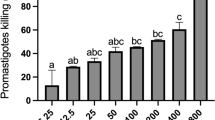Abstract
The leishmanicidal activity of Aloe vera leaf exudate (AVL) has been demonstrated in promastigotes and axenic amastigotes, but its effectiveness in animal models has not been evaluated. The presence of alkaloids, triterpenes, cyanidines, proanthocyanidines, tannins, and saponins in AVL was identified. Its effectiveness in four Leishmania donovani strains was studied both in promastigotes (IC50 ranged from 70–115 μg/ml) and amastigotes (IC50 ranged from 3.1–11.4 μg/ml). In amastigotes, the killing by AVL was facilitated through its induction of nitric oxide in leishmania-infected macrophages. The safety index was good as AVL up to 300 μg/ml remained non-toxic to monocytes and macrophages. In a L. donovani BALB/c mouse model, oral or subcutaneous administration of AVL (15 mg/kg body weight × 5 days) reduced parasitemia by >90% in the liver, spleen, and bone marrow without impairment of hepatic and renal functions. Collectively, we conclude that AVL shows promising antileishmanial activity and may provide a new lead agent in the treatment of Leishmaniasis.



Similar content being viewed by others
References
Akendengue B, Ngou-Milama E, Laurens A, Hocquemiller R (1999) Recent advances in the fight against leishmaniasis with natural products. Parasite 6:3–8
Ali MI, Shalaby NM, Elgamal MH, Mousa AS (1999) Antifungal effects of different plant extracts and their major components of selected Aloe species. Phytother Res 13:401–407
Bredt DS, Synder SH (1994) Nitric oxide: a physiologic messenger molecule. Ann Rev Biochem 63:175–195
Chappuis F, Sundar S, Hailu A, Ghalib H, Rijal S, Peeling RW, Alvar J, Boelaert M (2007) Visceral leishmaniasis: what are the needs for diagnosis, treatment and control? Nat Rev Microbiol 5:873–882
Desjeux P (2004) Leishmaniasis: current situation and new perspectives. Comp Immunol Microbiol Infect Dis 27:305–318
Dupouy-Camet J (2004) New drugs for the treatment of human parasitic protozoa. Parasitologia 46:81–84
Dutta A, Bandyopadhyay S, Mandal C, Chatterjee M (2005) Development of a modified MTT assay for screening antimonial resistant field isolates of Indian visceral leishmaniasis. Parasitol Int 54:119–122
Dutta A, Bandyopadhyay S, Mandal C, Chatterjee M (2007a) Aloe vera leaf exudate induces a caspase independent cell death in Leishmania donovani promastigotes. J Med Microbiol 56:629–636
Dutta A, Mandal G, Mandal C, Chatterjee M (2007b) In vitro antileishmanial activity of Aloe vera leaf exudate: a potential herbal therapy in leishmaniasis. Glyconj J 24:81–86
Ferro VA, Bradbury F, Cameron P, Shakir E, Rahman SR, Stimson WH (2003) In vitro susceptibilities of Shigella flexneri and Streptococcus pyogenes to inner gel of Aloe barbadensis Miller. Antimicrob Agents Chemother 47:1137–1139
Ghosh MN (2005) Fundamentals of experimental pharmacology, 3rd edn. Hilton & Company, Kolkata, pp 190–197
Guerin PJ, Olliaro P, Sundar S, Boelaert M, Croft SL, Desjeux P, Wasunna MK, Bryceson AD (2002) Visceral Leishmaniasis: current status of control, diagnosis and treatment and a proposed research and development agenda. Lancet Infect Dis 2:494–501
Handman E (2001) Leishmaniasis: current status of vaccine development. Clin Microbiol Rev 14:229–243
Harborne JB (1973) Phytochemical methods. A guide to modern techniques of plant analysis, 1st edn. Chapman and Hall, London
Holzmuller P, Sereno D, Cavaleyra M, Mangot I, Daulouede S, Vincendeau P, Lemesre JL (2002) Nitric oxide-mediated proteasome-dependent oligonucleosomal DNA fragmentation in Leishmania amazonensis amastigotes. Infect Immun 70:3727–3735
Kayser O, Kinderlen AF, Croft SL (2003) Natural products as antiparasitic drugs. Parasitol Res 90:S55–S62
Maes L, Vandenberghe D, Germonprez N, Quirijnen L, Cos P, Vanden Berghe D, Van Puyvelde L (2004) In vitro and in vivo activities of a triterpenoid saponin extract (PX-6518) from the plant Maesa balansae against visceral leishmania species. Antimicrob Agents Chemother 48:130–136
Newman DJ, Cragg GM, Snader KM (2000) The influence of natural products upon drug discovery. Nat Prod Rep 17:215–234
Pal S, Mandal A, Duttagupta S (2001) Studies on stibanate resistant Leishmania donovani isolates of Indian origin. Ind J Exp Biol 39:249–254
Paris C, Loiseau PM, Bories C, Breard J (2004) Miltefosine induces apoptosis-like death in Leishmania donovani promastigotes. Antimicrob Agents Chemother 48:852–859
Reynolds T, Dweck AC (1999) Aloe vera leaf-gel: a review update. J Ethnopharmacol 68:3–37
Roberts WL, Rainey PM (1993) Antileishmanial activity of sodium stibogluconate fractions. Antimicrob Agents Chemother 37:1842–1846
Sacks D, Noben-Trauth N (2002) The immunology of susceptibility and resistance to Leishmania major in mice. Nat Rev Immunol 2:845–858
Singh N (2002) Is there true Sb(V) resistance in Indian Kala azar field isolates? Curr Science 83:210–211
Stenger S, Donhauser N, Thuring H, Rollinghoff M, Boqdan C (1996) Reactivation of latent leishmaniasis by inhibition of inducible nitric oxide synthase. J Exp Med 183:1501–1514
Sundar S (2001) Drug resistance in Indian visceral leishmaniasis. Trop Med Int Health 6:849–854
The US Pharmacopeia (1995) Bacterial endotoxin test, 23rd revision. Mack Publishing, Easton
World Health Organization (2000) A report of the consultation meeting on traditional and modern medicine: harmonizing two approaches, 22–26 November 1999, Beijing, China., West Pacific Region
Yardley V, Croft SL (2000) A comparison of the activities of three amphotericin B lipid formulations against experimental visceral and cutaneous leishmaniasis. Int J Antimicrob Agents 13:70–75
Acknowledgements
The work received financial support from Council of Scientific and Industrial Research and Department of Biotechnology, Government of India. Avijit Dutta received a Senior Research Fellowship from Indian Council of Medical Research. We gratefully acknowledge the receipt of strains from the Leishmania Bank (Dr. Swadesh Duttagupta, Indian Institute of Chemical Biology, Kolkata) and Dr. Neeloo Singh, Central Drug Research Institute, Lucknow.
Author information
Authors and Affiliations
Corresponding author
Additional information
Chitra Mandal and Mitali Chatterjee should be considered as joint senior authors.
Rights and permissions
About this article
Cite this article
Dutta, A., Sarkar, D., Gurib-Fakim, A. et al. In vitro and in vivo activity of Aloe vera leaf exudate in experimental visceral leishmaniasis. Parasitol Res 102, 1235–1242 (2008). https://doi.org/10.1007/s00436-008-0899-2
Received:
Accepted:
Published:
Issue Date:
DOI: https://doi.org/10.1007/s00436-008-0899-2




